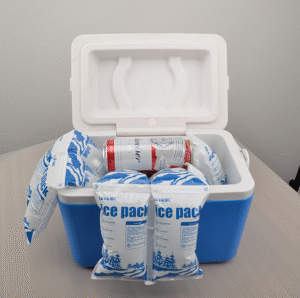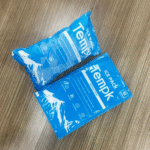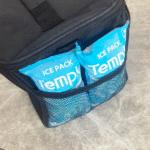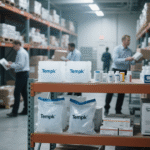كيس بلاستيكي جاف: 2025 الاستخدام الآمن, فتحات التهوية & تسميات
If you ship with a dry ice plastic bag, تبقيه تنفيس, mark UN1845 with net kilograms, and avoid airtight seals to stay safe and compliant. Dry ice sits at −78.5 °C and off‑gasses CO₂; in June 2025, USPS reaffirmed a 5 lb domestic air limit per mailpiece with venting and proper labels. IATA PI 954 still requires packaging to release gas.
-
How does a dry ice plastic bag vent CO₂ safely for air and ground shipping?
-
أيّ dry ice plastic bag material and thickness work best at −78.5 °C?
-
How to label boxes with UN1845, وزن صافي (كجم), والطبقة 9 hazard marks?
-
How much dry ice should a dry ice plastic bag hold for common lanes?
-
When is a dry ice plastic bag better than paper, هلام, or PCM packs?
How should a dry ice plastic bag be vented to stay compliant?
خلاصة القول: keep the dry ice plastic bag vented—never airtight—and ensure the outer package also vents. Carriers warn “do not place dry ice in sealed plastic bags,” and IATA PI 954 requires packagings that permit CO₂ release. USPS PI 9A echoes venting for mail.
Make it practical: Use an open‑mouth fold, micro‑perforations, or one or more 1/4″ vent holes. Do not tape or heat‑seal the mouth closed unless a clear vent path remains. Verify your cooler’s drain/vents are open so gas can escape into headspace rather than pressurizing the liner. These simple steps prevent bulged cartons and rejected freight.
Micro‑perforated dry ice plastic bag: when does it help?
Micro‑perfs create many tiny leak paths, bleeding CO₂ gradually and controlling debris. They pair well with insulated shippers when you need tidier pack‑outs. If debris control is secondary, a loosely folded open‑mouth liner is the fastest, most inspectable option. Keep any vent path unobstructed by dunnage.
| Venting Option | How it works | Where it helps | ماذا يعني لك |
|---|---|---|---|
| Open‑mouth fold | Mouth left loosely folded | Most frozen food shippers | Fast to pack; easy for acceptance checks. |
| Micro‑perforated bag | Pinholes bleed gas continuously | Debris control + uniform cooldown | Better housekeeping; still needs outer venting. |
| 1/4″ vent hole(ق) | Larger ports release pressure | Heavy loads or rough handling | Simple and obvious vent path for inspectors. |
Practical tips for you
-
Food SKUs: Line the cavity, add a separator, and place dry ice above product so cold sinks; keep the dry ice plastic bag vent clear.
-
البيولوجيا: Use validated shippers; keep secondary containers unblocked by the liner; no airtight coolers.
-
قبول: Pre‑print UN1845 and net kg labels; never write on the Class 9 label face.
القضية الميدانية: A frozen‑meal brand switched from sealed poly to micro‑perforated, loosely folded dry ice plastic bags. Bulged cartons disappeared and audits cleared without findings across 48‑hour air lanes.
Which dry ice plastic bag material and thickness should you choose?
Start with LDPE 2–4 mil or low‑temperature‑tough films (EVA‑modified LDPE or LLDPE). Thicker gauges resist abrasion from pellets and blocks, while paper/kraft “dry ice bags” add scuff resistance. Whatever you choose, ال dry ice plastic bag must stay vented.
لماذا يهم: Standard LDPE nears its brittleness limit around the dry‑ice point; blends with EVA or LLDPE improve cold‑flex and seal strength when handled roughly. For heavy or sharp loads, spec 3–4 mil; for light debris control, 1.5–2 mil works if vented and protected by the shipper.
Will an ordinary LDPE dry ice plastic bag crack at −78.5 °C?
It can—especially if flexed hard. EVA/LLDPE blends retain toughness better at low temperatures and reduce split risk at seams or folds. If you must use plain LDPE, up‑gauge and minimize bending points, and always keep vents open to lower internal stress.
| خيار | سمك نموذجي | نقاط القوة | ماذا يعني لك |
|---|---|---|---|
| LDPE liner (open/vented) | 2–4 mil | مرن, food‑contact, easy fold | Good all‑rounder; never airtight. |
| Micro‑perforated poly | 0.8–2 mil | Airflow + debris control | Confirm low‑temp toughness; still vent outer. |
| Kraft “dry ice” bag | Paper | Abrasion‑resistant | Pair with moisture barrier; keep path to vent. |
How do you label shipments that include a dry ice plastic bag?
Mark the outer box with “Dry Ice” or “Carbon Dioxide, صلب,” “UN1845,” the net dry ice weight in kilograms, and shipper/recipient addresses; apply the Class 9 ملصق. IATA PI 954 does not require a Shipper’s Declaration when dry ice cools non‑DG goods. USPS domestic air allows up to 5 lb dry ice per mailpiece and prohibits international mail with dry ice. Keep the dry ice plastic bag and the package vented.
Copy‑and‑use SOP (صافي كجم + علامات):
-
Weigh remaining dry ice just before hand‑off.
-
Convert lb→kg using kg = lb / 2.2.
-
Print on outer carton:
-
"الجليد الجاف" أو "ثاني أكسيد الكربون, Solid”
-
“UN1845”
-
“Net ___ kg”
-
Shipper & recipient names/addresses
-
-
Apply Class 9 ملصق; do not write on the label face.
-
Confirm venting: no sealed dry ice plastic bag; no airtight coolers.
How much dry ice should a dry ice plastic bag hold in transit?
Plan 5–10 lb per 24 h as a starting point, with insulation and ambient conditions driving most variance. أ dry ice plastic bag contains debris and organizes pack‑out, but it does not replace insulation. Run lane pilots with data loggers and add 10–20% for doorstep dwell.
| سيناريو | العزل | المحيط | أيام | الجليد الجاف (رطل) | ماذا يعني لك |
|---|---|---|---|---|---|
| وجبات مجمدة, قطعة | EPS 1.5″ | Normal | 2 | 16-20 | Use bag for debris; مسار تنفيس مفتوح. |
| بوظة, صيف | EPS 2″ | حار | 2–2.5 | 22–28 | Add porch buffer; vented bag essential. |
| البيولوجيا, هواء | VIP | Normal | 1 | 6–8 | Less refrigerant; وضع العلامات الصارمة. |
عملي, lane‑ready tips
-
Right‑size insulation first: Headspace and wall R‑value dominate hold time; ال dry ice plastic bag won’t fix poor void fill.
-
Top‑load the ice: Place dry ice above products so cold sinks; keep vents unblocked.
-
Train for safety: Follow 5,000 ppm TWA / 30,000 ppm STEL CO₂ limits; use gloves and eye protection.
Real‑world outcome: After switching to vented liners and pre‑printed UN1845 labels, a seafood shipper cut acceptance rejections to zero and held arrival temps below −18 °C on 2‑day air.
When is a dry ice plastic bag better than paper, هلام, أو PCM?
استخدم dry ice plastic bag للممرات المجمدة (≤ - 18 درجة مئوية) and debris control. Kraft bags resist abrasion; poly liners are more moisture‑tolerant and transparent for inspection. Use gel/PCM for chilled (1-10 درجة مئوية) الممرات; they are not hazardous but cannot maintain deep‑freeze conditions like dry ice.
| استخدام الحالة | كيس بلاستيكي جاف | Paper/Kraft Bag | هلام/PCM | ماذا يعني لك |
|---|---|---|---|---|
| الأطعمة المجمدة | Excellent (تنفيس) | جيد | Poor | Keep frozen solid, tidy pack‑outs. |
| البيولوجيا | Excellent (PI954) | جيد | N/A for −70 °C | امتثال + ultra‑cold range. |
| Chilled SKUs | Overkill | Overkill | Best | Choose PCM for 1–10 °C. |
2025 trends for dry ice plastic bag buyers
Regulatory clarity and reusables are reshaping choices in 2025. USPS Publication 52 (June 2025) reaffirmed domestic air limits (≤5lb) والتنفيس. IATA acceptance materials spotlight “permit gas release,” and carrier job aids increasingly flag sealed bags as disqualifying. Reusable shippers are rising, often cutting refrigerant mass while retaining a vented dry ice plastic bag for debris control.
آخر تقدم في لمحة
-
Clearer postal rules: Domestic air dry ice is allowed with venting, تسميات, and ≤5 lb per piece; international mail remains prohibited.
-
Vented SKUs mainstream: Micro‑perfs and 1/4″ vent options are easy to source and inspect.
-
Material shifts: EVA/LLDPE blends gain favor for low‑temperature toughness and seam durability at −78.5 °C.
نظرة السوق: Analysts project ~7–8% CAGR for dry ice through 2032, driven by frozen foods, e‑commerce, والبيولوجيا. Standardize vented liner specs and dual‑source supply ahead of peak seasons.
التعليمات
س 1: Can I heat‑seal a dry ice plastic bag?
نعم, only if vented—use micro‑perfs, 1/4″ holes, or leave a deliberate gap. لا تقم بمنعة محكمة الإغلاق.
Q2: What must go on the outer box label?
"الجليد الجاف" أو "ثاني أكسيد الكربون, صلب,” “UN1845,” وزن الثلج الجاف الصافي (كجم), shipper/recipient addresses, and a Class 9 ملصق.
س 3: What is the USPS limit by air?
حتى 5 رطل per domestic air mailpiece; venting and proper marks required. No international mail with dry ice.
س 4: Will micro‑perforations replace carton venting?
لا. They help the dry ice plastic bag تنفيس, but the outer package must also release gas.
س 5: Are CO₂ exposure limits relevant at pack‑out?
Yes—design ventilation around 5,000 ppm TWA and 30,000 ppm STEL to protect teams.
ملخص & التوصيات
النقاط الرئيسية: أ dry ice plastic bag must be تنفيس, never airtight; label boxes with UN1845 and net kilograms; choose LDPE 2–4 mil or EVA/LLDPE for cold‑flex; and right‑size insulation before adding ice. Train teams on CO₂ limits and carrier acceptance.
الخطوات التالية:
-
Specify a vented dry ice plastic bag (gauge + vent style) and request samples.
-
Run a lane pilot with data loggers and the estimator above.
-
Pre‑print UN1845 labels and add SOPs to your pack‑out checklist.
-
Book a Tempk review to finalize your lane‑by‑lane BOM and test plan.
حول Tempk
We engineer practical cold‑chain systems that hit target temps with minimal refrigerant. Our specialists validate vented dry ice plastic bag workflows, label maps, and acceptance steps so you reduce claims and pass audits. Expect lower spoilage and smoother hand‑offs, backed by SOPs and lane pilots.
دعوة إلى العمل: Need a compliant pack‑out fast? Talk to a Tempk expert for a free liner spec and print‑ready UN1845 label set.
























